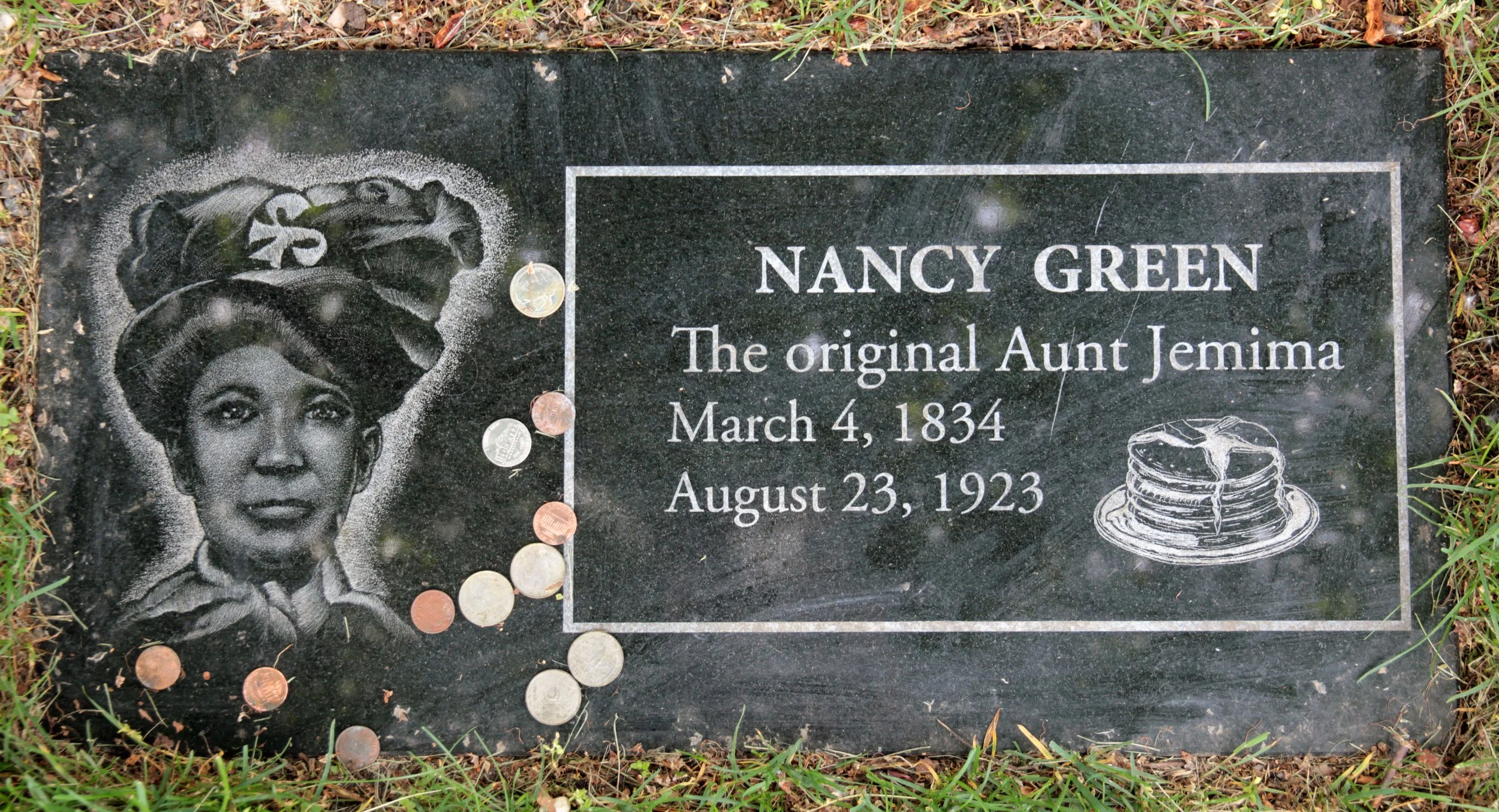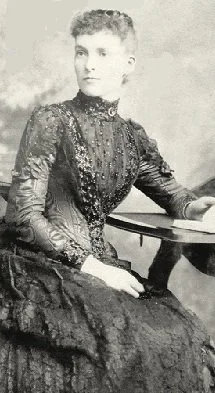
Notable Women from the Three Sites
Aunt Jemima ad in the Saturday Evening Post.
Nancy Green’s cemetery marker, Oak Woods Cemetery, Chicago. Photograph by Ryan J. Cook.
Sophia Hayden, 1888, when she was an architecture student at Massachusetts Institute of Technology (MIT). MIT Museum.
Helen Douglas Charnley, ca. 1870s.
Marion Buckingham Ream Stephens Vonsiatsky.
Nobia Franklin, portrait from ca. 1915 when she founded her first beauty school.
Gwendolyn Brooks holding a copy of her book, A Street in Bronzeville.
THE 1893 WORLD’S FAIR: Nancy Green and Sophia Hayden
Nancy Green (1834—1923) was hired by the R.T. Davis Milling Company to portray “Aunt Jemima” for their new advertising campaign for their instant pancake and waffle mixes. Green, who had been formerly enslaved in Kentucky, took on the role for 20 years, debuting her version of this minstrel show “mammy” character to visitors at the World's Columbian Exposition. She worked as a cook and housekeeper both before and after her time as the first Aunt Jemima until her death from a traffic accident in 1923. At the time of her death, she lived in Chicago's Bronzeville neighborhood.
Sophia Hayden Bennett (1868—1953) designed the Woman’s Building at the 1893 Worlds’s Fair. Born in Chile and raised near Boston, Hayden was the first female graduate of architecture from MIT in 1890. Hayden won the competition to design the Woman’s Building which was judged by the Board of Lady Managers and architect Daniel Burnham. This was the only building of her design to be built, having experienced significant resistance and rejection in the architectural profession. After working as a drawing teacher and painting avocationally, Hayden died of pneumonia in her eighties.
Charnley House: Helen Charnley and Marion Stephens
Helen Douglas Charnley (1854–1930), eponymous owner of the Charnley House, married James Charnley (1844–1905) in 1872. “Helen was born in Galena, Illinois, but grew up in Chicago” (NARA 1921); she “was the daughter of his former partner, John Madison Douglas (1819—1891), and Amanda Marshall Douglas (1819–1890). John Douglas was a prominent member and later president of the Illinois Central Railroad"; like James Charnley, he also made money from interests in rail and lumber companies (Graff 2020:46).
“James and Helen, their two daughters—Helen (1876–1883) and Elizabeth ‘Bettie’ (1878–1883)—and their son, Douglas (1874–1927) lived in several” nearby Chicago locations before moving to Astor Street in 1892 (Graff 2020:46). James and Helen hired architects Dankmar Adler and Louis Sullivan, whom they likely knew personally through family and social ties, to design a new house for them (Graff 2020:47).
“In 1902, James and Helen left Chicago and the Charnley House, and a series of renters, and then owners, moved in. After James’ death in 1905, Helen traveled widely, living in England, Italy, Switzerland, and France (NARA 1921), though she left behind few records of those years. According to a report from the American Consular Service, Helen Charnley died from pneumonia at the Hotel Lausanne-Palace in Lausanne, Switzerland, on January 4, 1930,” interred alongside her son Douglas in Montreux-Clarens, Switzerland (Graff 2020:105).
Marion Buckingham Ream Stephens (1877–1963) married Redmond Davis Stephens (1874–1931) in 1903. They held the wedding reception in Ream’s family home in Chicago’s first “Gold Coast,” the elite Prairie Avenue District (Chicago Tribune 1903a:7). After several years in a “bachelor apartment” at 87 Rush Street (Chicago Tribune 1903b:12), the Stephenses began renting the nearby Charnley House in 1906, buying the house in 1911 (Graff 2020:109).
Marion was a staple of the Chicago society pages, “with her clothes and appearances at various balls and other social events noted and sometimes accompanied by photographs (Chicago Tribune 1907:3; English 1911)” (Graff 2020:109). For his part, Redmond was a '“wealthy club member, society man, and athlete” (Chicago Tribune 1918c:1), who was a partner in the law firm of Scott, Bancroft, Lord, and Stephens and a president of the Chicago and Oak Park Elevated Railroad Company. For a time, the couple lived what seemed, outwardly at least, an ideal elite existence.
Yet Redmond later publicly lamented that “the house on Astor street could not hold [Marion's] interest” (Chicago Tribune 1918a:15). The couple went through a well-reported divorce in 1918, made acrimonious in no small part due to her rejection of what the Charnley house symbolized to her: the constraints of their marriage “and her assigned role in the cult of domesticity” (Graff 2020:110). In 1922 she announced her impending marriage to a “Russian youth with whom she will pursue happiness in a workman’s cottage”—the White Russian Fascist, Anastase Andreivitch Vonsiatsky, whom she had met in Paris (Chicago Tribune 1922a:2). Marion continued to support Vonsiatsky vocally and financially through the tumult of World War II, the Cold War, and their 1952 separation. She died in 1963.
Mecca Flats: Nobia Franklin and Gwendolyn Brooks
Madame Nobia Franklin-McCoy (1892–1934) was born in Houston, Texas; there she “created an empire around beauty culture, capitalizing upon wage-earning African Americans, who by World War I had more ‘expendable income and access’ to mass-produced consumer goods’ (Steptoe 2016:58). Her business was third-ranked in the country after Poro Company from Annie M. Turnbo-Malone and Madame C.J. Walker’s business (Steptoe 2016:58-59). Franklin and her husband and business partner, William McCoy, along with her adopted daughter, Abbie Franklin, moved to Chicago in 1922. A story on this move relates that ‘as Chicago is the center of the universe and all railroads lead to it from everywhere, Madame Franklin finally decided to make this city the central point for conducting the rapidly growing or increasing business…’ (The Broad Ax 1922:3)” (Graff 2022/under review).
Franklin's beauty empire came to encompass several stand-alone beauty parlors, including one at 3342 South State Street in the Mecca Flats, and a factory-laboratory-college several blocks away at 3361 South Indiana Avenue, where “they produced toilet preparations and employed faculty who taught ‘The Franklin System’ to additional would-be entrepreneurs (Chicago Defender 1924a:4)” (Graff 2022/under review).
“Nobia Franklin died suddenly on October 30, 1934 from ‘acute indigestion’ at a ‘mock wedding’ held at the Allen Temple A.M.E. Church (Chicago Defender 1934:2). She left her estate to her two adopted daughters, with Abbie Franklin Jemison as executrix (Chicago Tribune 1934:16). That her expansive beauty empire extended to the Mecca Flats has not been celebrated as part of that building’s history” (Graff 2022/under review).
Gwendolyn Brooks (1917–2000) was the first Black author to win the Pulitzer Prize (in 1949 for Annie Allen), a poetry consultant to the Library of Congress, and the poet laureate of Illinois (1968–2000). Brooks famously captured 1930s-era life in the Mecca Flats with her long poem, In the Mecca (1968). Brooks, who was born in Topeka, Kansas, but moved to Chicago as a child, worked as a secretary in the Mecca in the 1930s. “Writing after the Mecca was demolished and Mies’ modernist campus made real, Brooks begins the poem with this quasi-site history of the Mecca as a call to witness:
Sit where the light corrupts your face.
Miës Van der Rohe retires from grace.
And the fair fables fall (Brooks 1968:5).
The poem continues with images of a mother, Mrs. Sallie, and her search for her lost child, Pepita Smith, within the Mecca, ultimately ending with the discovery of Pepita’s murder. But, like the ambiguity of Jimmy Blythe’s songs, Alfred, a Mecca tenant and teacher, reckons with the aftereffects of the murder: “something, something in Mecca/continues to call!.../A material collapse/that is Construction” (Brooks 1968:1)” (Graff 2022 in press).
< Previous Page | Next Page >






